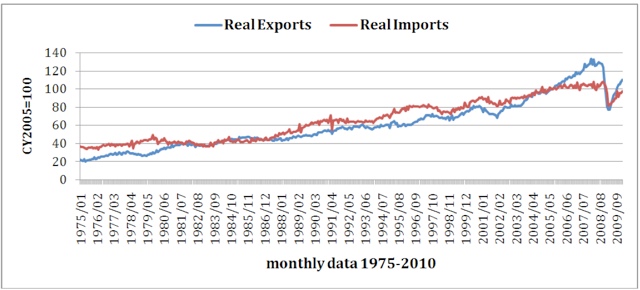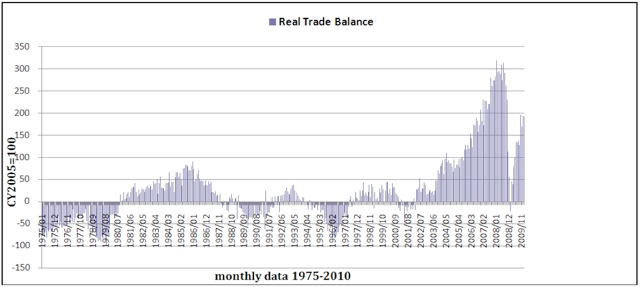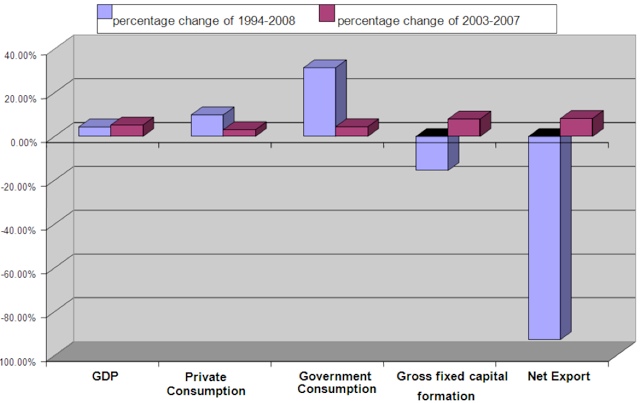The global financial crisis of 2007/08 has led to generally weak performance indicators of the Japanese economy. While Japan was by far one of the most advanced countries in Asia, the negative shock spread gradually to all sectors of the economy. Western economists accused Japan of relying too much on exports for growth, but the question was about how critical export growth was to the Japanese economy. The following is an analysis of the recent trends in Japan’s trade balance.
Nominal exports were on a declining trend with the largest drop (of 34%) occurring in 2009. Nominal Imports also started to decrease due to weak domestic demand. The import decline was larger than the export reduction in 2009 (Table 1). However, the high nominal value of total imports in recent years is accounted for by a rise in import prices rather than an increase in volume. By contrast, the total value of real exports and imports has shown sharp drops since the beginning of 2008, with a slight recovery in April-May 2009 (Figure 1) and a sharp rise in the real trade surplus (Figure 2). This has to be seen in the context of a 200% increase in the real trade surplus for the period 2005-2008 (Figure 2).
Table 1: Nominal Exports and Imports
| Year |
Exports million Yen |
Annual increase % |
Imports million Yen |
Annual increase % |
| 2000 | 495,256 | 8.15 | 371,538 | 16.05 |
| 2001 | 465,835 | -5.94 | 381,821 | 2.77 |
| 2002 | 494,797 | 6.22 | 379,294 | -0.66 |
| 2003 | 519,341 | 4.96 | 399,576 | 5.35 |
| 2004 | 582,951 | 12.25 | 443,929 | 11.10 |
| 2005 | 626,318 | 7.44 | 522,971 | 17.81 |
| 2006 | 716,308 | 14.37 | 621,665 | 18.87 |
| 2007 | 797,254 | 11.30 | 674,030 | 8.42 |
| 2008 | 773,522 | -2.98 | 733,183 | 8.78 |
Source: Bank of Japan
The slow pace of recovery led by external conditions is likely to continue because of weakened domestic demand (Bank of Japan 2010). This reflects the expectation of continuing decline in public consumption, unchanged levels of business fixed investment despite the improvement in corporate profits, and the failure of private consumption to respond to the government’s measures for stimulating households’ spending.
Figure 1: Real Exports and Imports
Source: Bank of Japan
Japan has had a sporadic real trade surplus, as it increased by more than 200% for the period 2005-2008. Much of it is explained on the export side. An export boom was maintained by an increase in worldwide consumption, arguably facilitated by the so-called “credit bubble.”
Figure 2: Real Trade Booms (trade balance, seasonally adjusted)
Source: Bank of Japan
The analysis shows the Japanese economy depends on external market conditions to define the path of its economic recovery. In particular, Japan relies heavily on regional markets not only with respect to trade in goods and services, but increasingly as destinations for foreign investment. Indeed, Asia has become an increasingly important component in the overall shift of Japan’s net income from oversees away from trade in goods and services and towards interest and dividends. This shift is in turn having a major impact on regional development in Asia.
For instance, portfolio and direct foreign investment income overtook the export of goods and services in 2005; subsequently investment has been a major component of the Japanese Current Account, and the one that seems likely to lead its recovery, despite direct investment abroad falling by 47% during 2009. While as a result of the credit crunch there were fluctuations in the level of Japanese investment in all regions, the fall was heavily concentrated in North America (an annual drop of 78%) with the level of investment in Asia and Europe remaining stable. The largest amounts went to Asia (28%); Central and South America (23.2%) and the EU (22.9%) (Bank of Japan 2010).
Portfolio investment (equity and debt securities) and returns from such investment have been picking up gradually,butregional performance was mixed. Direct investment in the Asia-Pacific region rose steadily during the 2000’s. This is arguably part of a permanent long-term trend and linked to a continued expansion of Japanese foreign direct investments in Asia over the last three decades. Although causation is not implied, the capital outflows from Japan to emerging markets have risen in accordance with the current government economic growth and regional strategies. The Ministry of Economy, Trade and Investment (the former MITI) recommends development of a system that fosters income flows back to Japan from emerging countries in Asia. This new growth mechanism reinforces competitiveness via commitment of channeled-back funds to future innovations and distributing them to household income. This is likely recognition by the Japanese government that in a mature, post catch-up high- speed growth economy, new ways need to be built to find high yielding investments.
From an ASEAN (The Association of Southeast Asian Nations) point of view, East Asia has become a less important source of investment, though Japan’s share within this has increased, , principally as a result of increased diversion of Taiwanese and South Korean flows into China. While there has also been an increase in China’s share of ASEAN inflows from East Asia, these should be seen as complementary to those of Japan. Indeed, Chinese investment in ASEAN can in many cases be directly related to Japanese investment in China and the development of China as a key element in the regional production system.
Returning to the initial question, if Japan is an export-led economy, as it is often presumed, any fall in exports would have negative effects on the output. If the Japanese GDP is disaggregated into its major components, it is evident that both the Gross fixed capital formation (Investment) and the Net export went up significantly during the export bubble in 2003-2007.
Figure 3: Disaggregated Japanese Output
Source: Statistics of National Accounts, Japan
NOTE: This briefing is based on two GPI Policy Papers published in 2009 and 2010, co-written by Viara Bojkova, David Bruce and Chris Dixon.



















